Unseen Forces: Lesser Known Natural Disasters
Natural disasters often steal our attention, yet amidst ‘the big ones’, numerous lesser-discussed catastrophes silently shape our world. This exploration takes us into discussion some lesser known natural disasters.
1. Dust Storms: The Silent Giants:
Dust storms, or haboobs, may not draw headlines like tornadoes or hurricanes, but these massive walls of dust, fueled by strong winds, can wreak havoc. Obscuring landscapes and causing respiratory issues, dust storms are a reminder that nature’s fury takes many forms.
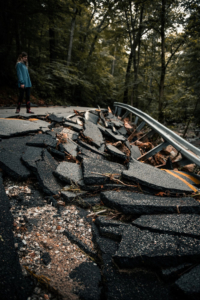
While less common in Canada to experience a severe dust storm (like they would more regularly in the Saharan Desert), areas with significant human activities, such as agriculture, deforestation, and construction, can experience dust storms. For example, the Dust Bowl in the United States during the 1930s was a result of poor land management practices combined with severe drought conditions.
- Combine a drought and a wind storm, and a dust storm is highly possible.
2. Sinkholes: Nature’s Unseen Cracks:
Beneath our feet, the hidden danger of sinkholes lurk. Triggered by factors like heavy rainfall or human activities, these sudden collapses can swallow buildings or roads, revealing the delicate balance between what we build and the Earth’s forces.
https://www.cbc.ca/news/canada/calgary/sinkhole-emergency-calgary-road-repairs-1.6852642 Here is a CBC news article giving example of a sink hole appearing in SE Calgary, Alberta May 2023.
https://www.wctrib.com/news/4-missing-after-canadian-home-falls-in-sinkhole And here is a huge, and tragic sink hole example (from the West Central Tribune) in Saint-Jude, Quebec in 2010.
3. Volcanic Hail & Ash: Nature’s Fiery Fury:
Volcanic hail, or lapilli, is a phenomenon where small volcanic rock fragments rain down during an eruption. Beyond flowing lava, eruptions bring dangerous projectiles, causing damage to infrastructure and human safety. Volcanic hail paints a vivid picture of the impact of a volcanic event.
The eruption of Mount St. Helens in Washington (1980) generated a massive ash cloud that reached high into the atmosphere. The ash was composed of fine rock and mineral particles that were pulverized during the eruption. The ash cloud traveled for hundreds of miles, affecting ground traffic, air traffic, weather patterns, and visibility.
Since the 1980 eruption, Mount St. Helens has remained active, with ongoing geological monitoring. It serves as a valuable natural laboratory for scientists studying volcanic processes and ecosystem recovery.
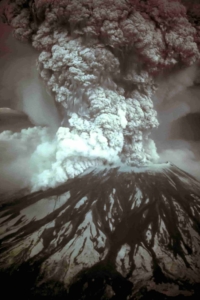
-
-
-
-
-
-
- The ash cloud from Mount St. Helens traveled eastward across the United States & Canada and travelled significant distances in the Northern Hemisphere
- The ash cloud posed a severe threat to aviation as it can damage aircraft engines and other critical components. In response to the eruption, significant airspace restrictions and flight cancellations were implemented.
- The ashfall had a profound impact on the local ecosystem, affecting vegetation, water bodies, and wildlife. However, over time, the area around Mount St. Helens has undergone a process of ecological recovery.
-
-
-
-
-
Image by Austin Post – Mount St. Helens, Washington May 18, 1980 Eruption Images, Public Domain, https://commons.wikimedia.org/w/index.php?curid=3157557
4. Drought: Earth’s Parched Embrace:
Drought, a slow and insidious disaster, silently grips regions, causing water scarcity and agricultural crises. The prolonged absence of rainfall or lack of enough winter snowfall reveals the vulnerability of ecosystems and challenges our ability to adapt to changing climate patterns.
Of course, the most famous drought was during the “Dirty 30’s”, though that was not the last one our Country has experienced. Would it surprise you to know that we are (as of Dec 2023) currently experiencing drought conditions?
https://agriculture.canada.ca/en/agricultural-production/weather/canadian-drought-monitor/current-drought-conditions The Agriculture section on the Canada.ca website portrays this:

5. Landslides and Avalanches: Nature’s Cascading Fury:
Landslides and avalanches, triggered by heavy rainfall or snowfall, pose significant threats to mountainous regions. Their sudden and destructive nature highlights the need for careful land-use planning and early warning systems in vulnerable areas.
In our own Rocky Mountains and all of Canada’s vast mountain regions, we must be well educated on avalanche safety. If you plan to venture out hiking, skiing, or any other winter sport of choice, consider taking an avalanche safety course and thoroughly educating yourself
Here are some landslide and avalanche examples from within Canada:
- Frank Slide (1903) – Alberta:
- One of the most famous landslides in Canadian history occurred in the town of Frank, Alberta, in 1903. A massive rockslide, known as the Frank Slide, buried part of the town under millions of tons of limestone rock from Turtle Mountain. The slide was triggered by the unstable geological formations in the area.
- These two photos are of a trip we took through the Crowsnest Pass to see it. I can honestly say that no matter how many times I walk through the rubble, I am astounded by the magnitude of it.
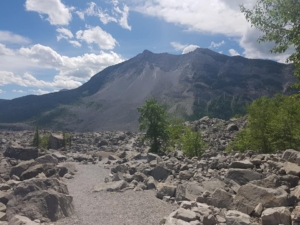
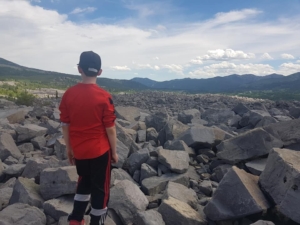
- Hope Slide (1965) – British Columbia:
- The Hope Slide is one of the largest landslides in recorded Canadian history. It occurred in the Nicolum Valley near Hope, British Columbia, burying a stretch of Highway 3. The slide was triggered by heavy rainfall and the instability of the underlying rock formations.
- Mount Meager Landslide (2010) – British Columbia:
- In 2010, a massive landslide occurred on Mount Meager in British Columbia. The debris flow traveled down Capricorn Creek, creating a natural dam on Meager Creek. The event raised concerns about the potential for glacial outburst floods and impacted the landscape in the region.
- Rogers Pass Avalanches (Multiple Events) – British Columbia:
- Rogers Pass in the Selkirk Mountains of British Columbia is known for its history of avalanches. The area experiences frequent avalanche activity, and extensive avalanche control measures are in place to ensure the safety of the Trans-Canada Highway and the railway that pass through the region.
- Dawson Landslide (2015) – Yukon:
- In 2015, a large landslide occurred near the community of Dawson City in Yukon. The slide blocked the flow of the Yukon River, causing concerns about potential flooding. The incident highlighted the dynamic nature of the northern landscapes and the potential for geomorphic changes.
6. Blowing Snow, Freezing Rain, and Fog: Atmospheric Alchemies:
Blowing snow, freezing rain, and fog are atmospheric phenomena that can create hazardous conditions for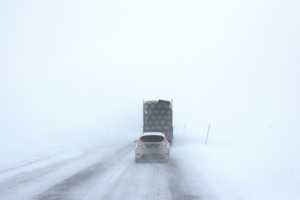 transportation and daily life. These seemingly subtle events underscore the impact weather can have on our daily activities, demanding respect for the forces of nature.
transportation and daily life. These seemingly subtle events underscore the impact weather can have on our daily activities, demanding respect for the forces of nature.
Pro-Tip: If you do not have to be on the roads during these conditions, it is best to avoid it. I would hazard a guess that insurance companies would also give the same advice!
There are far too many examples of these 3 conditions in our wonderous Canadian homes to share. In fact, if you have an example with a lesson learned, please email it to me at BridenAcademy@bridensolutions.ca – if I get enough of them, I will create a post sharing all our personal “Lessons Learned”
7. Smoke: Beyond the Campfire

Smoke, often accompanying wildfires, can blanket vast areas, affecting air quality and visibility. Strong winds become the silent helpers, spreading fires and intensifying their impact. I cannot remember a year in the last 5 that we have not had wildfire smoke in our forecast. Some years worse than others of course.
Wildfires: Lets first learn about their purpose: while often seen as destructive events, they play several important roles in ecosystems and can have both short-term and long-term ecological impacts.
- Wildfires are a natural and essential part of the ecological cycle. Some plant species have evolved to be fire-dependent, relying on wildfires to clear away dead vegetation, open up space for new growth, and stimulate seed germination.
- Wildfires break down organic matter and release nutrients back into the soil. This process, known as mineralization, replenishes the soil with essential nutrients like nitrogen and phosphorus. The enriched soil can support the growth of new vegetation.
Knowing that wildfires (particularly the non-human started ones, but that’s an entirely different post) are good for ecosystems, does not make the smoke and air quality easy for us oxygen breathing humans.
Educate yourself on the air quality index found HERE to keep yourself safe, and follow proper protocol provided by your local authorities.
8. Cold Temperatures and Wind Chill: Nature’s Temperature Extremes:
Extreme cold temperatures challenging us to cope with the diverse climates that Canada can unleash. Best practice for cold temperatures and wind chill include proper outer wear, avoiding exposure of skin, and limited time in the elements.
wind chill include proper outer wear, avoiding exposure of skin, and limited time in the elements.
HOW WIND CHILL WORKS:
- When wind blows in cold conditions, it intensifies the perception of coldness on exposed skin, a phenomenon known as wind chill. Wind chill is more than just a subjective feeling – it reflects the increased rate of heat loss from the body. As wind speed rises, it strips away the thin layer of warm air near the skin, accelerating the cooling process.
- This heightened cooling effect not only makes the air feel colder but also increases the risk of frostbite and hypothermia. In regions prone to severe winter weather, wind chill advisories and warnings are crucial for public safety, guiding individuals to take precautions such as dressing in layers, covering exposed skin, and limiting outdoor activities to prevent cold-related health issues.
Our Territories (Yukon, NWT & Nunavut) hold the overall coldest temperatures on a year-to-year average basis, but some of the provinces sneak in there with some particularly cold moments on occasion! Wikipedia mentions a few documented -60C moments over the past 100+ years. Brrr!
Conclusion:
In the intricate web of natural disasters, these lesser-known events weave a narrative of Earth’s complexity. By understanding and respecting the full spectrum of calamities, we can better prepare for the unseen forces shaping our world.
We did not discuss specifically what to do, or how to get through these disasters in this article. My hope however is for everyone to see that a disaster does not need arrive in the form of a tornado, a flood, or an earthquake to be a disaster. A disaster by definition is a sudden, catastrophic event that causes significant disruption, destruction, and/or distress, and I’ll add to that, often unexpected.
Nature’s surprises are boundless, and our journey to move forward through it is so much easier if we are prepared. Knowledge is power my friends. We are on the right track. Have a great day!



